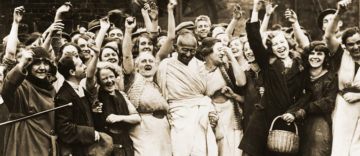 Priya Satia in Aeon:
Priya Satia in Aeon:
After the Second World War, historians asked us to shift our focus from great men to the actions and experiences of ordinary people, to culture rather than institutions. This methodological shift to ‘history from below’ was political, supporting a democratic vision of political, social, intellectual and cultural agency as the Cold War stoked authoritarian impulses in the East and West. It sought to rectify historians’ paternalistic habit of writing about the people ‘as one of the problems Government has had to handle’, as E P Thompson put it, as objects rather than subjects of history. Influential as this trend was, great-man history retained a cultural hold too and, today, the would-be ‘great men’ dominating political stages around the world, however caricature in form, challenge democratic visions of how history has been and should be made. ‘History from below’ succeeded in throwing out the chimera of great men while preserving the chimera of the nation that was the most common excuse for their invocation. Revisiting its origins might reveal why.
Thompson is perhaps the figure most popularly associated with ‘history from below’, specifically his totemic work, The Making of the English Working Class (1963). Expansive as its cast is, its geographical scope is constricting. Though set in the era of British conquest of vast swathes of the world, it barely acknowledges that reality. This is doubly strange, given that Thompson wrote it while decolonisation was forcing Britons to contend with the ethics of empire, and was himself descended from a line of colonial missionaries deeply engaged with such matters. His classic text created an island template for the most progressive British history of the late-20th century, unwittingly legitimising the nostalgic view of ‘Little England’ that has culminated in Brexit. The book’s enormous impact also ironically endowed Thompson with fairly robust great-man status himself, as the iconic historian-activist of his time.
More here.
